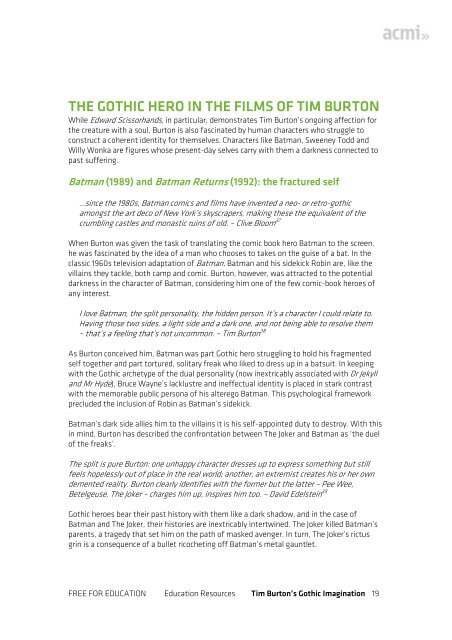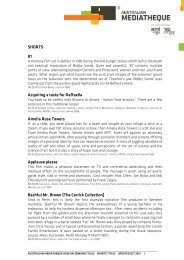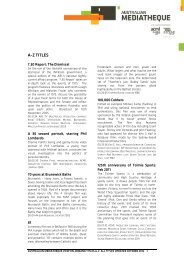Tim Burton's Gothic Imagination
Tim Burton's Gothic Imagination
Tim Burton's Gothic Imagination
You also want an ePaper? Increase the reach of your titles
YUMPU automatically turns print PDFs into web optimized ePapers that Google loves.
THE GOTHIC HERO IN THE FILMS OF TIM BURTON<br />
While Edward Scissorhands, in particular, demonstrates <strong>Tim</strong> Burton’s ongoing affection for<br />
the creature with a soul, Burton is also fascinated by human characters who struggle to<br />
construct a coherent identity for themselves. Characters like Batman, Sweeney Todd and<br />
Willy Wonka are figures whose present-day selves carry with them a darkness connected to<br />
past suffering.<br />
Batman (1989) and Batman Returns (1992): the fractured self<br />
…since the 1980s, Batman comics and films have invented a neo- or retro-gothic<br />
amongst the art deco of New York’s skyscrapers, making these the equivalent of the<br />
crumbling castles and monastic ruins of old. – Clive Bloom 37<br />
When Burton was given the task of translating the comic book hero Batman to the screen,<br />
he was fascinated by the idea of a man who chooses to takes on the guise of a bat. In the<br />
classic 1960s television adaptation of Batman, Batman and his sidekick Robin are, like the<br />
villains they tackle, both camp and comic. Burton, however, was attracted to the potential<br />
darkness in the character of Batman, considering him one of the few comic-book heroes of<br />
any interest.<br />
I love Batman, the split personality, the hidden person. It’s a character I could relate to.<br />
Having those two sides, a light side and a dark one, and not being able to resolve them<br />
– that’s a feeling that’s not uncommon. – <strong>Tim</strong> Burton 38<br />
As Burton conceived him, Batman was part <strong>Gothic</strong> hero struggling to hold his fragmented<br />
self together and part tortured, solitary freak who liked to dress up in a batsuit. In keeping<br />
with the <strong>Gothic</strong> archetype of the dual personality (now inextricably associated with Dr Jekyll<br />
and Mr Hyde), Bruce Wayne’s lacklustre and ineffectual identity is placed in stark contrast<br />
with the memorable public persona of his alterego Batman. This psychological framework<br />
precluded the inclusion of Robin as Batman’s sidekick.<br />
Batman’s dark side allies him to the villains it is his self-appointed duty to destroy. With this<br />
in mind, Burton has described the confrontation between The Joker and Batman as ‘the duel<br />
of the freaks’.<br />
The split is pure Burton: one unhappy character dresses up to express something but still<br />
feels hopelessly out of place in the real world; another, an extremist creates his or her own<br />
demented reality. Burton clearly identifies with the former but the latter – Pee Wee,<br />
Betelgeuse, The Joker – charges him up, inspires him too. – David Edelstein 39<br />
<strong>Gothic</strong> heroes bear their past history with them like a dark shadow, and in the case of<br />
Batman and The Joker, their histories are inextricably intertwined. The Joker killed Batman’s<br />
parents, a tragedy that set him on the path of masked avenger. In turn, The Joker’s rictus<br />
grin is a consequence of a bullet ricocheting off Batman’s metal gauntlet.<br />
FREE FOR EDUCATION Education Resources <strong>Tim</strong> Burton’s <strong>Gothic</strong> <strong>Imagination</strong> 19










